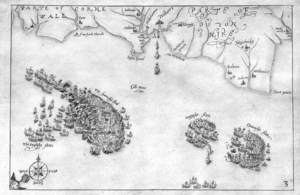Incredibly rare maps of the defeat of the Spanish Armada at risk of export
Culture Minister stops export of ten hand-drawn maps depicting the defeat of the Spanish Armada in 1588

Valued at £600,000 the works are the only surviving contemporary drawings of the battle
- Valued at £600,000 the works are the only surviving contemporary drawings of the battle
Culture Minister Caroline Dinenage has placed an export bar on a set of ten hand drawn maps of the defeat of the Spanish Armada valued at £600,000 plus VAT.
It is hoped that a UK gallery or institution will come forward to acquire the treasures for the nation which depict the greatest naval battle of the early modern period. The drawings were completed by an unknown draughtsman, possibly from the Netherlands and are undated, although are thought to be from the years immediately after the battle.
The defeat of the Spanish Armada in 1588 has a totemic place in English history and has been employed at various moments of national crisis including the threats of invasion from Napoleonic France and Nazi Germany.
The most famous images of the battle extant are a series of engravings completed in 1590 by Augustine Ryther. The original drawings have been lost and the maps at risk of export are a very rare survivor of this iconic moment of history.
Although the works are highly unlikely to be the preliminary drawings for the Ryther engravings, it is also unlikely that they were copied from the engravings. There is a possibility that the works are copies of the drawings by Robert Adams that were used by Ryther. The works appear to have been abandoned mid-way through completion following the publication of the Ryther engravings as a number included Dutch text of a type accompanying the engravings while others did not.
The committee noted that the drawings offered a rare, contemporary insight into the artistic material culture, often associated with Queen Elizabeth I, that followed the battle.
Culture Minister Caroline Dinenage said:
The defeat of the Spanish Armada is central to the historical tale of what makes Britain great. It’s the story of plucky England defeating a greater foe and helped to create the world we live in today. These incredibly rare drawings are a very important part of the story of our nation and I hope, even in these challenging times, that a buyer can be found so they can be enjoyed by members of the public for generations.
The Minister’s decision follows the advice of the Reviewing Committee on the Export of Works of Art and Objects of Cultural Interest (RCEWA). The committee noted that the works offered a rich resource for the study of the development of the marine painting genre and the outstanding research potential offered by the drawings due to their rarity.
The RCEWA made its recommendation on the grounds of the drawing’s outstanding significance for the study of the Armada story on British history and identity and how it affected marine depictions.
Committee member Peter Barber said:
Robert Adams, Surveyor of the Queen’s Works, and military engineer, was one of the most skilled cartographic draughtsmen of Elizabethan England, the delicacy of his work resembling the finesse of miniaturists such as Hilliard. His maps of the Armada, engraved in significantly amended form by Augustine Ryther, became the official image of one of the most celebrated episodes in English history. Their importance in the creation of England’s historic self- image cannot be exaggerated. They provided the models for tapestries which served as a backdrop for the proceedings of the House of Lords and for nearly 250 years.
These drawings are as close as one is ever likely to get, in the absence of the originals, to the appearance of Adams’s manuscript maps but there is much fresh information that can be gleaned from them. That they were probably copied, surreptitiously, by a Dutch artist for illicit publication in the Netherlands demonstrates the importance of the defeat of the Armada not only for England but for Europe as a whole. The drawings need to be saved for the nation so that the full story behind the creation of these iconic images can be properly researched.
The decision on the export licence application for the drawings will be deferred until 9 October 2020. This may be extended until 9 January 2021 if a serious intention to raise funds to purchase it is made at the recommended price of £600,000 plus VAT.
ENDS
Notes to editors
- Organisations or individuals interested in purchasing the drawings should contact the RCEWA on 0845 300 6200.
- Details of the drawings are as follows: A set of ten ink and watercolour drawings on paper depicting the progress and defeat of the Spanish Armada. The drawings are by an unknown draughtsman, possibly from the Netherlands, and are undated. They are in generally good condition.
- Provenance: The drawings were in the possession of Roger Wilbraham MP (1743-1829) in 1828. The earlier provenance is not known. The Wilbraham family sold the drawings at Sotheby’s sale of 20 June 1898. They were bought by J. Pearson and Co., a London bookseller, and later sold to William Waldorf Astor (1848-1919). After this, ownership transferred by descent until the recent sale.
- The Reviewing Committee on the Export of Works of Art and Objects of Cultural Interest is an independent body, serviced by The Arts Council, which advises the Secretary of State for Digital, Culture, Media and Sport on whether a cultural object, intended for export, is of national importance under specified criteria.
- The Arts Council champions, develops and invests in artistic and cultural experiences that enrich people’s lives. It supports a range of activities across the arts, museums and libraries – from theatre to digital art, reading to dance, music to literature, and crafts to collections. www.artscouncil.org.uk.